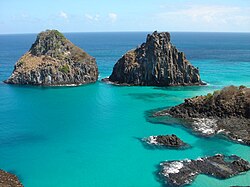| Sound of Jura | |
|---|---|
| An Linne Rosach (Scottish Gaelic) | |
 Small group of skerries in the Sound of Jura, looking Northwest towards Jura | |
| Location | Western Scotland |
| Coordinates | 55°58′50″N5°45′20″W / 55.98056°N 5.75556°W |
| Type | Sound |
| Frozen | No |
The Sound of Jura (Scottish Gaelic : An Linne Rosach) is a Sound in Argyll and Bute, Scotland. It is one of the several Sounds of Scotland. It is to the east of the island of Jura and the west of Knapdale, in the north of the Kintyre Peninsula, of the Scottish mainland. Lochs that lead to the sound include Loch Sween, and Loch Killisport (Caolisport (Scottish Gaelic)). It is not to be confused with the Sound of Islay, which lies between Jura and Islay. Most of Jura's small population lives on the east coast, overlooking the sound.
Contents
- Gulf of Corryvreckan
- Crinan Canal
- Lighthouses
- Ruadh Sgeir Lighthouse
- Skervuile Lighthouse
- George Orwell
- Gallery
- References
- External links
- The north end is particularly treacherous, being filled with skerries, small islands, strong tidal currents and whirlpools.










